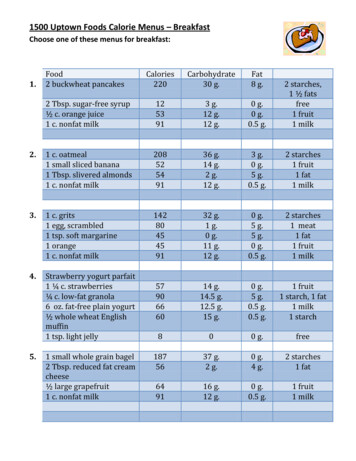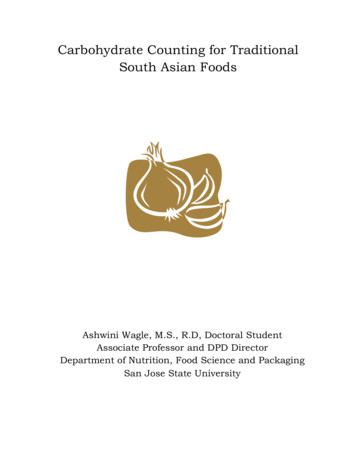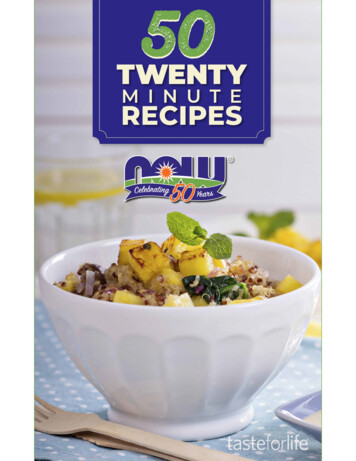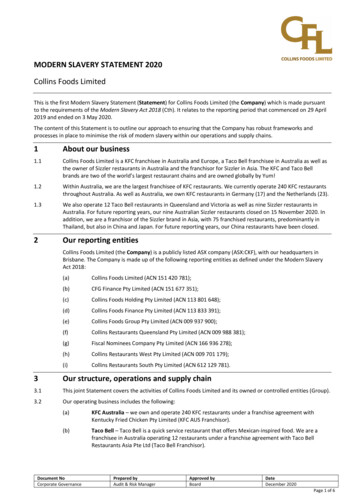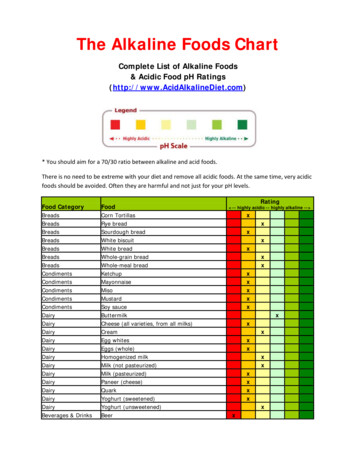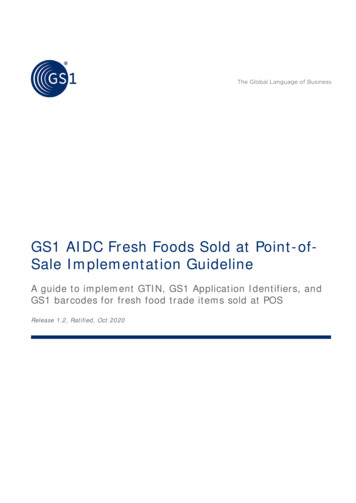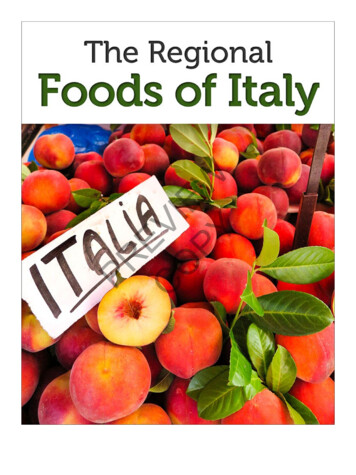
Transcription
PREC VIO EPY W
IntroductionPreviewing this book?Please check out our enhanced preview, which offers a deeper look at this guidebook.Food guides for the ultra curious, Approach Guides take an in-depth look at a destination’s local cuisine to help you understand its food culture, navigate menus and discover regional specialties.PREC VIO EPY WItaly offers an unrivaled culinary experience. With a food landscape that changes from region toregion, there is always something you have not tried. But the really special thing is when you tastean old favorite that redefines how you think about it from then on: osso bucco from Lombardia, prosciutto di Parma from Emilia-Romagna, mozzarella di bufala from Campania, or even something aseveryday as coffee in Friuli-Venezia Giulia. It is your to discover.What’s in this guidebook A region-by-region review. This Approach Guide provides a high-level review of each ofItaly’s regions, giving you detailed information on local specialties across all courses: antipasti, primi, secondi and dolci.Food culture. Italy takes its food seriously and this guidebook helps you navigate the landscape, covering topics such as when not to order a cappuccino and how much to tip.Italian food basics. To acquaint you with the basics of Italian cuisine, this guidebook offers detailed profiles of Italian salumi and pasta types, as well as a comprehensive Italian-toEnglish glossary of food-related terms.Recommendations. To help in your selection process, we point out not-to-be-missed localspecialties.Information the way you like it. As with all of our guides, this book is optimized for intuitive, quick navigation; information is organized into bullet points to make absorption easy;and the most important information is front and center.Contact us anytimeOur readers are our greatest inspiration. Email us at founders@approachguides.com to let us knowabout your experience with Approach Guides — many of our recent updates have been inspired bycustomers like you. We personally respond to every email.We hope that this guidebook enables you to get even more out of what is sure to be an exceptionalculinary tour of Italy.Have a great trip and buon appetito!
David and Jennifer RaezerFounders, Approach Guideswww.approachguides.comGet our Italian Wine Guide. Given their nearly inextricable linkage in Italy, we highly recommend using this food guide in conjunction with our “Italian Wine Guide” (www.approachguides.com/italy) or our wine app for the iPhone or iPad (wine.approachguides.com).Looking for Some Culture?PREC VIO EPY WConsider downloading our other guidebooks to Italy.
PREC VIO EPY W
Guide to the Regional Foods of ItalyVersion 1.5by David Raezer and Jennifer Raezer 2017 by Approach Guidesll rights reserved. No part of this book may be reproduced in any form or by any electronic or mechanical means, without permission in writing from the publisher (excluding Creative Commons images). Further, this book is licensed foryour personal enjoyment only and may not be resold or given away to other people.Copyright, licensing and attribution information can be found in the metadata for all images and illustrations.Approach Guides and the Approach Guides logo are trademarks of Approach Guides LLC. Other marks are the propertyof their respective owners.PREC VIO EPY WAlthough every effort was made to ensure that the information was as accurate as possible, we accept no responsibilityfor any loss, damage, injury or inconvenience sustained by anyone using this guidebook.Approach GuidesNew York, NYwww.approachguides.comISBN: 978-1-936614-01-1
ContentsIntroductionHow It WorksRestaurantsEat Slow FoodCoffee BarsCulinary BasicsPasta PrimerSalumi PrimerPREC VIO EPY WThe Regions of ItalyAbruzzo e MoliseAlto Adige (Südtirol) - iuli-Venezia degnaSiciliaToscanaUmbria
Valle d’AostaVenetoExtrasCommon Foods and TerminologyWhere It’s FromMake a SuggestionThe Wines of ItalyContinuing Travel in ItalyOur RecommendationsPREC VIO EPY WPacking ListAbout Approach GuidesJoin Us!VideosMore from Approach GuidesFree Updates and Enhancements
—In the heart of every man,wherever he is born,whatever his education and tastes,there is one small corner which is Italian,that part which finds regimentation irksome,the dangers of war frightening,strict morality stifling,that part which loves frivolous and entertaining art,admires larger-than-life-size solitary heroes,and dreams of an impossible liberationfrom the strictures of a tidy existence.—PREC VIO EPY WLuigi Barzini, “The Italians”
How It WorksPREC VIO EPY WIn these sections, we cover basic protocol for ordering and eating in Italian restaurants and coffeebars. It’s simple stuff, but it helps to have some visibility on what to expect.
PREC VIO EPY WRestaurantsOsteria alle Testiere. Venice, Italy.To help make your restaurant experience as good as it can be, we offer a few tips and provide insightsinto the local perspective.TimingLunch runs from 12-3pm; dinner generally starts around 8pm, with seatings until 10-11pm. Dinnertimes may skew slightly earlier in small towns.ReservationsWhile lunch is certainly a walk-in affair, we highly recommend making reservations for dinner. A
reservation, made even a few hours in advance, goes a long way in signaling respect for the restaurantand certainly increases the likelihood of getting a better table.At the Table: First Exchanges and Ordering Water. Without fail, the first question always asked by the server after you sit down is whattype of water you want. The assumption is that you will be having bottled water, which is veryeconomical in Italy. The question, therefore, is what type: “acqua naturale (still) or gassata /frizzante (sparkling)?”The quick order. Italians order quickly after sitting down at a restaurant, so don’t be surprised if your server is soon asking to take your order. He is not trying to rush you, though. Ifyou need more time, just let him know. Once your order has been placed, however, the paceslows down dramatically.How much food to order. Do not feel that each person is expected to order an antipasto,a primo and a secondo. Splitting plates and sharing is standard practice. Simply indicate howmany of each item you want and the message will be clear. To communicate that a dish is tobe shared, say the name of the dish followed by “uno piatto in due” (one plate divided in two).Getting a waiter’s attention. Should you require the server’s attention, simply signal andsay: “signore” for male or “signora” for female.Wine with dinner is typical. Since it is assumed that you will likely be drinking wine atdinner, the wine list (la carta dei vini) will be presented straight away. Wine lists are almostexclusively focused on Italian wines and are typically organized by region. Most often you willfind the local wines from the region in which you are dining highlighted. And when in doubt,go local. After you taste the wine, the server will pour the glasses and then place the bottle atyour table; for the most part, you are responsible for subsequent pours of the bottle.PREC VIO EPY W Author tip: To navigate Italian wine lists, we recommend using our “Italian Wine Guide”(www.approachguides.com/italy) or Approach Guides Wine, our wine app for the iPhone oriPad (wine.approachguides.com).Course TermsMenus are organized into a consistent set of courses. Antipasto. An antipasto is the appetite-whetting pre-course of an Italian meal. Traditionalofferings are cured meats (salumi), marinated vegetables, olives, peppers and bruschetta.Primo (primo piatto). The “first” course typically consists of pasta, soup and risotto. Sincepasta courses in Italy are intended to be eaten in advance of main courses (secondi), they tendto be modestly smaller than those you typically encounter outside of the country.Secondo (secondo piatto). The “second” course is the most substantial one. It featuresmeat, poultry and fish.Contorno. Side dish.Dolce. Dessert.
— Pages Missing —Download the complete book online at www.approachguides.com
Eat Slow FoodWe have found that the best restaurants in Italy are those that remain true to the local cuisine. Thecountry’s Slow Food movement has championed this perspective and developed a great resourcefor travelers looking to eat local.You will see Slow Food stickers on the doors of all of the restaurants that meet its criteria: sourcingfood from local, high quality artisanal producers; having a menu that is true to the local cuisine andachieves successful prepared results; and delivering good value for money. Getting the book or app. We recommend purchasing a Slow Food book, called “Osteried’Italia.” It really helps with restaurant selection and does a great job at highlighting the mosttraditional dishes. Buy the book online before you go, or if you want to travel light, purchaseit as an app.Italian only. Unfortunately, the book is only written in Italian (a limited English version isavailable in some bookstores in Milan, Rome and Florence). However, even if your Italianneeds some work, you can easily discern the restaurant names and the recommended dishes,which are highlighted in bold typeface.PREC VIO EPY W
PREC VIO EPY WPasta PrimerPasta “fatta in casa” (homemade).Dry and Fresh PastaThere are two basic types of pasta.
Dry pasta (pasta secca). Made from flour and water, pasta secca is factory-made packagedpasta. Although the type of flour (farina) can vary, it is typically made from durum wheat.Fresh pasta (pasta fresca). Made from flour and (typically) eggs, pasta fresca is hand madefor immediate consumption. While pasta across the board is excellent in Italy, pasta frescais the way to go if available. The homemade quality of these pastas affords them a profoundtexture, making what is already an incredible experience even better. These pastas also mightbe identified on menus as “fatta in casa” (made in house) or “fatta a mano” (made by hand).Author tip: While fresh pasta is traditionally made with eggs, some locations — mostly insouth Italy — use flour and water only. These pastas will often be marked on menus as senzauova (without eggs) or acqua e farina (water and flour).Pasta Lunga (Long Pasta)PREC VIO EPY WThe quintessential dry pastas, long pastas favor long, cylindrical shapes since they are made by extrusion or rolling and cutting. They are best suited to olive oil and tomato sauces, rather than chunkymeat sauces. This is because long pastas have a hard time holding the meat when it is twirled on afork. Bucatini. A thick long pasta with a hole running through the center. Think of it as hollowspaghetti. Capellini. The thinnest long pasta, cylindrical in shape.Linguine. Most prevalent in south Italy, linguine actually has an ever-so-slight curvature(the source of its name, “little tongues”), despite its flat appearance.Spaghetti. This thin, cylindrical long pasta is probably the most famous of all.
PREC VIO EPY WFettuccini.Fettucce (Ribbon Pasta)Although they can be made into very good dry pastas, ribbon pastas are best in fresh versions. Typically made from pasta dough that is rolled flat and cut into strips, they favor flat profiles and tend tobe slightly thicker than long pastas. But more important, due to their hand-crafted nature, they feature more porous textures that are ideally suited to butter- and cream-based sauces that have a hardtime clinging to dry long pastas. Bavette. A long, narrow ribbon pasta that is similar to fettuccine in width.Fettuccine. Slightly wider than the thinnest ribbon pasta, tagliolini, fettuccine is also knownas trenette in Liguria.Lasagne. Lasagne are large sheets of pasta.Pappardelle. Slightly wider than tagliatelle, it is the widest of the flat ribbon pastas.Pizzocheri. A wide-cut flat ribbon pasta that is made chiefly from buckwheat flour. It is aspecialty of Lombardia’s Valtellina region.Tagliatelle. This flat ribbon pasta is slightly wider than fettuccine. It is the classic pasta matchfor butter-based bolognese meat sauce.
— Pages Missing —Download the complete book online at www.approachguides.com
gently cold smoked and spiced with pepper and garlic. Moist and finely ground, it is designed to bespread on bread, similar to pâté. It is a specialty of the Marche region.CoppaAlso known as capocollo, coppa is salt-cured and air-dried whole pork shoulder and/or neck; thiscompares to prosciutto (from the hind leg) and lonza (from the loin). It is flavored with various spices(pepper, cinnamon, cloves and nutmeg) and aged for three to six months. Capocollo is traditionallyfound in the regions of Basilicata, Campania, Emilia-Romagna, Puglia and Umbria.CulatelloPREC VIO EPY WProduced in the area around Parma, culatello is made from the leanest part of the hind leg of thepig; this compares with Prosciutto di Parma, which is made from the whole leg. As with Prosciutto diParma, culatello is air dried and salt cured, however, it undergoes an incremental step: it is encasedin a membrane (similar to a salami), in which it undergoes 6-12 months of aging. Overall, culatellooffers a fuller-bodied flavor than Prosciutto di Parma and is a real treat.
— Pages Missing —Download the complete book online at www.approachguides.com
PREC VIO EPY WThe Regions of ItalySee in Google Maps.Italy’s Food: Region-by-Region
Alto Adige (Südtirol) - TrentinoThe cuisine of Alto Adige (Südtirol) - Trentino has a strong Germanic influence. Accordingly, dishesoften employ spices and preparations unknown in the rest of Italy.PREC VIO EPY WAntipastiSpeck.SalumiSalumi hold high importance in Alto Adige - Trentino. Luganega trentina (pl. luganeghe). Luganega is mild fresh sausage, served cooked. Madefrom pork, it is traditionally seasoned with cinnamon, coriander, nutmeg, pepper and sometimes Parmigiano-Reggiano.Mortandella. Not to be confused with mortad
Italian food basics. To acquaint you with the basics of Italian cuisine, this guidebook of-fers detailed profiles of Italian salumi and pasta types, as well as a comprehensive Italian-to-English glossary of food-related terms. Recommendations. To help in your selection process, we point out not-to-be-missed local specialties. Information the way you like it. As with all of our .File Size: 2MBPage Count: 46

